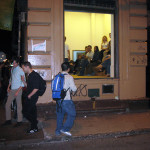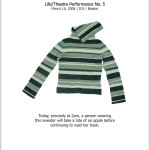By MATTHEW NASH
On Sunday, March 16th, my students from The Art Institute of Boston will perform Lee Walton's "Life/Theatre: ICA" at the Institute of Contemporary Art. [1] This piece came about through a collaboration between myself and Rosanna Flouty of the ICA, and it is one of the performance pieces hosted by the ICA in conjunction with the exhibition "The World As A Stage".
----
Lee Walton has made every minor action in the world his art, or so he claims. This is not a claim made in his artist statement, and the easy-going, California attitude of Walton himself would never allow for such a bold statement. Yet it is right there in the work: Lee Walton is the author of all things mundane.
Perhaps we should step back a little and look at "Life/Theatre" in all its various forms to understand how this can happen. Certainly my typing these words right now cannot be a performance by Walton, right? Then again, under the right circumstances, I may be doing exactly what he wants me to do. I don't know. What I do know is that each time I step outside, if I am in the right frame of mind, I can find work by Lee on every street and in every gesture of those around me.
My first encounter with the "Life/Theatre" project was at Art In General in the spring of 2005. AIG is on a busy side street, and the ground floor has large storefront windows. A sandwich-board sign informed us that "Life/Theatre" was playing, and we entered the space to find rough wooden bleacher seating, constructed to face the street. Walton was there, chatting with friends, and others lounged watching the theatre.
The "theatre," of course, was the street outside. Life was theatre. It is a simple idea, sure, but the longer I sat there, the more I became aware of how the framing of the window, the theatre seating, and the construction of the experience conspired to cause me to over-evaluate everyone I saw. Each person who came into view was an actor in a play with no plot.
After a while, I noticed that certain "characters" were recurring: a man spilled Gatorade in front of the window, cursed and walked off quickly; a woman dropped her broken umbrella and kicked it into the street. Seeing these people a few times, I realized that Walton was staging some of the events, and that not all the events in front of me were "life," nor were they all "theatre." My delight at discovering this twist was undercut by my annoyance at having my initial perceptions shattered: I had enjoyed thinking of the whole world as a play. Yet, once I figured out that there were actors in the mix, I suddenly questioned the motivations of everyone who passed in front of our bleachers. Was that man yelling at the fire hydrant really angry at an inanimate object, or an actor hired by Walton? The knowledge that some of the actions I saw were created by the artist made me want to know more about the motivations of those that weren't directed by Lee.
At the end of the "performance" we were given a set of postcards, each describing a project by Walton. Some were labeled "Life/Theatre Performance" and others "Experiential Project," depending on whether the viewer would engage in a passive or active relationship to the work. A "Life/Theatre" card, for example, read "On W. 22nd Street off 10th Avenue, a slightly inebriated man pushing his bicycle will display audible signs of frustration and kick an orange." An "Experiential Project" card gave directions: "Baxter's Pub - 79 Baxter Street - Sit at the Bar. When the bartender greets you, simply touch your nose."
Upon receiving these cards, I'll admit that I completely underestimated Lee. My initial reading of the cards was that the artist was claiming simple actions or moments in the world, but that since no one, or nearly no one, would be present for these "performances" that they were merely implications of events one might see, rather than actual "performances" for an audience of nil. Talking with Lee, however, it is clear that each and every piece occurred as described, faithfully executed by an actor hired by Walton. This, in my mind, fulfills the requirements necessary for a project like this, but having seen none of the performances I am left with the same reaction as I had when I thought they had never happened: Walton has claimed authorship over the mundane in everyday life.
Let me propose a scenario. Having acquired a stack of the "Life/Theatre" postcards, you see "At the 23rd Street N-R-W subway station near Broadway, a woman with crutches [...] surface, show signs of frustration, rotate 360 degrees, then vanish." Aware that this woman and her frustration were a "performance" by Lee Walton, you nod knowingly and get on with your day. Now, suppose you walk from Broadway and 23rd north to Times Square, where you see a man sneeze. Did you just see a work of art by Lee Walton? Was that sneeze any more, or less, important because you didn't have a card claiming it as work by an artist?
Ultimately, this is the core of Walton's work, that "life" and "theatre" are just constructs, and that context defines our actions. Considering the art world (where both Lee and I tend to reside) it is a fair assessment that "life" and "theatre" mix quite regularly, and that the affectations of artists are but one form of theatre created for specific audiences at certain times. By redirecting that knowledge, and that knowing acceptance of false pretenses, Walton both questions and claims ownership over the actions of everyday life. In Walton's world, everything that is "life" is also "theatre" and there is really no need to make a distinction.
Considering Walton's interaction with my students, and his direction for their work in "Life/Theatre: ICA," I find reinforcement in this notion. Not only has Walton asked a group of art school students to perform mundane tasks at the ICA while wearing sweaters; not only have these tasks been derived by the explorations of the ICA's teen arts program studying the people in their everyday lives; not only that it occurs during "The World As A Stage": Walton has asked that each performer also create a performance outside the ICA during their everyday life. This might be re-enacting their ICA action at a subway station, or it might be simply to perform a routine action at home late at night. There might be no audience at all to see the "performance," only the performer and their thoughts.
This, for me, is where "Life/Theatre" really meets my expectations of experiential performance art. Seeing the "Life/Theatre" cards and imagining a person enacting the description, one knows that they can become a witness to an act created by an artist. However, when the "performances" are created in a context that cannot be seen, and exist only for the performer, we are forced to question what types of actions we engage in that are performances only for ourselves. Some people sing in the shower, others play air guitar, stack their dishes neatly, dance while they vacuum, and a million other actions that make life more interesting but exist for no audience. Walton wants us to consider all of these moments, our life in public and the one in private, as sites for art. By claiming authorship and directing an audience to see the mundane as art, he points out that the world is full of false pretenses and socially constructed norms. The moments where these fall away and something else is revealed, we see an unfiltered view of the theatre of everyday life.
- “Life/Theatre” at Art In General
- One of the “Life/Theatre” cards
- One of the “Life/Theatre: ICA” cards
----
[1] - due to the Big RED & Shiny production schedule, this was written prior to the event.
BIG_RED_ON-THE-TOWN_16144831_thumb.jpg) See images from "Life/Theatre: ICA" |
The Institute of Contemporary Art
Lee Walton
"Life/Theatre: ICA" occurred at precisely 2pm on Sunday, March 16th, 2008 at the ICA.
All images are courtesy of the artist.







